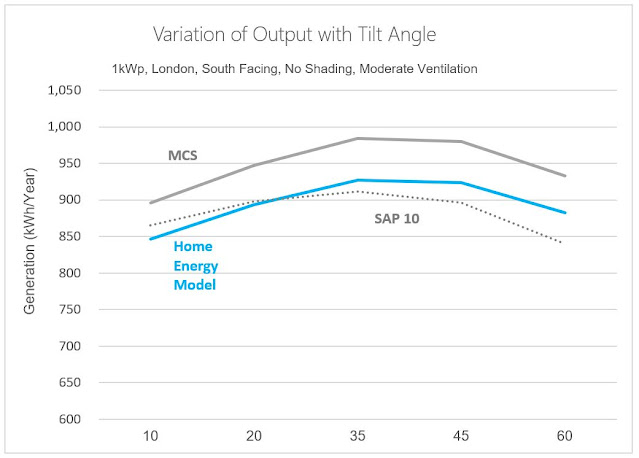An Assessment of the Solar Energy Calculation in the Home Energy Model
 |
| The HEM introduces a new variable - the degree of ventilation of the solar panels |
Alongside the consultation on the Home Energy Model (HEM) a paper was published describing how solar PV generation and the proportion of energy used in the property (self-consumption) would be calculated.
Also available for the consultation is a prototype of the calculator implemented as a web page which can be played with.
The solarblogger has been busy checking how this new tool will treat solar energy and in this article I'll be sharing my findings.
The Method
The energy output of the solar PV system is calculated according to BS EN 15316-4-3:2017 using the hourly procedure described in the standard.
Inputs to the calculation are:
- rated peak power (kWp) of the solar array under standard test conditions
- location of the house (which selects a climate file with irradiation data)
- orientation
- tilt angle
- the area of the solar array, and its height above the ground
- shading (captured as part of the general shading of the building)
- 'ventilation strategy' of the solar panel
This last input captures the difference between above-roof (rack mounted) solar that is rear-surface free, classed as Moderately Ventilated and in-roof (roof integrated) solar which is classed as Unventilated.
Since the HEM is modelled on a half-hour time slice, it can account for real-time variation in the PV generation and the energy demand in the property to estimate how much solar energy is used in the home, or available to charge a battery, divert to a hot water cylinder or export to the grid, as appropriate. Generated electricity is assumed to be allocated in this order of priority
- To meet household demand
- Into battery storage (until full)
- To a PV diverter (until the hot water reaches maximum set temperature)
- Exported to the grid
Consumed electricity is assumed to be taken in this order of priority:
- From solar PV generation
- From battery storage
- From the grid
Testing
The online tool provided with the consultation helpfully comes with two case studies - a detached house with two bedrooms, 82m2, with a heat pump serving both hot water and space heating and a bungalow with one bedroom, 40.5m2, direct electric heating and hot water.
The detached two bedroom house was selected as the base model and features of the solar PV system were varied and the annual energy generated was derived for each case. This figure was compared with:
- the solar calculation in SAP 10.2, the predecessor to the HEM
- the solar calculation used for the Microgeneration Certification Scheme (MCS)
Panel Ventilation
The HEM introduces a new variable ignored in both the SAP10 and MCS calculations - the degree of ventilation of the rear of the panel. Solar PV panel power output decreases with increasing temperature of the panel, so a panel installed with an open back side should produce more energy than the same panel with less ventilation to the rear.
Choosing 'Moderately Ventilated' produced around 2% more energy than SAP10, whereas 'Unventilated' produced 3% less (see graph at top of article). The difference between Moderately Ventilated and Unventilated - 5% - is in broad agreement with this study by Viridian Solar / Cambridge University into the difference in yield between roof integrated solar and above roof solar which found a difference of 3%.
All the following comparisons are made with the ventilation set at Moderately Ventilated.
Location
The HEM solar yield prediction was compared with SAP10 and MCS at five different locations in England (rest of UK is not offered in the consultation version, which is for English regulations).
The HEM follows SAP10 closely.
Tilt Angle
The annual energy yield from a solar panel in the UK is optimal at around 35 degrees tilt angle from horizontal. The HEM model follows the shape of the MCS prediction albeit at a lower predicted energy, closer to SAP 10.
Orientation
A solar panel facing south will generate the most energy yield each year in the UK, with progressively less energy the further from south it is facing, though the effect is less pronounced than most people expect due to the very high level (around 40%) of diffuse light - that reflected from clouds, sky, surroundings - in the UK.
The HEM deviates very significantly from both the MCS and SAP10 predictions as the panel orientation moves further from south. It starts matching SAP 10 closely when facing due south, but by north facing SAP 10 predicts 64% more energy yield.
This aspect of the HEM model is very concerning and warrants further investigation to check for a bug.
Self Consumption
The output from the software also shows the amount of solar energy used in the property and the amount exported to the grid, so it was possible to derive a scatter plot from all of the results generated in the above analyses and take a look at how the model predicts self consumption.
The plot below shows how the predicted proportion of solar generation that would be self-consumed changes as the size of the solar installation increases. In this scenario, there is no battery storage or solar PV diverter in the house.
Comparing with some work done previously on SAP10 self consumption prediction shows that the HES predicted self consumption ratio drops more quickly than was the case in SAP 10. It is worth noting that SAP 10 was based on a very small data set and it is possible that there is more and better data available against which to test the HEM both with and without battery storage.
Conclusion
The testing given to the HEM on its solar energy prediction has only raised one serious red flag - that the modelling of panel orientation looks off and should be checked.





